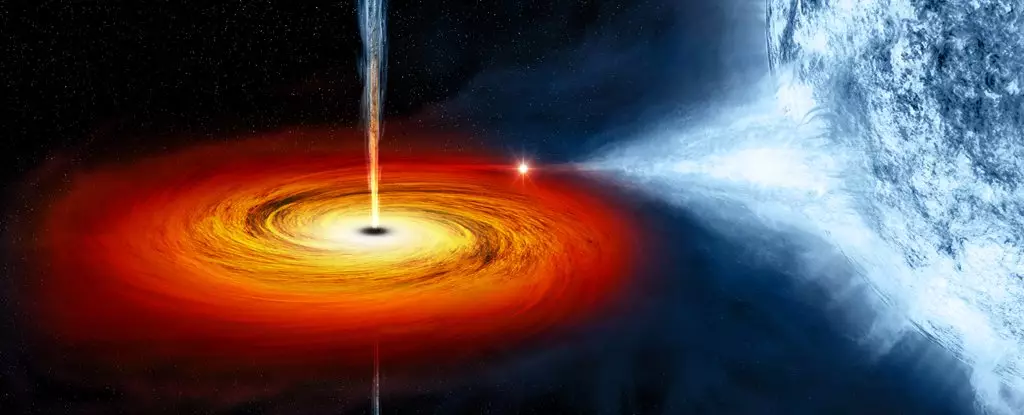For decades, astrophysicists have theorized that the most energetic gamma rays in the universe predominantly emanate from extreme cosmic events, particularly those associated with supermassive black holes at the centers of distant galaxies. These powerful rays are akin to the radiative aftermath of immense energy generation during black hole accretion. However, a groundbreaking study has unexpectedly redirected our focus to the relatively nearby V4641 Sagittarii, located approximately 20,000 light-years from Earth. In the constellation Sagittarius, this microquasar is challenging previously held beliefs about where and how such high-energy gamma rays can originate.
V4641 Sagittarii consists of a black hole roughly six times the mass of our Sun, consuming material from a massive companion star that boasts a mass of three solar masses. This unique interaction generates an extraordinary amount of radiation, comparable to a cosmic particle accelerator. The astonishing discovery that gamma-ray emissions from this system can reach energies of up to 200 teraelectronvolts (TeV)—a scale that dwarfs the energy of visible light by a factor of 200 trillion—has shifted the paradigm in gamma-ray astronomy.
The classification of V4641 Sagittarii as a microquasar is particularly significant. Microquasars are essentially smaller counterparts to standard quasars, with mass and operational scales considerably reduced. Traditionally, scientists have observed that gamma rays emitted from microquasars are of a much lower energy on the order of tens of gigaelectronvolts, making the findings from V4641 Sagittarii revolutionary and deserving of deeper investigation. Sabrina Casanova of the Institute of Nuclear Physics Polish Academy of Sciences remarked on the unexpected nature of these findings: “Photons detected from microquasars have usually much lower energies than those from quasars.” This evidently challenges the established narrative in high-energy astrophysics.
The discovery that a nearby microquasar could produce radiation comparable to its much larger counterparts opens up fresh lines of inquiry. It stimulates discussions about the mechanics behind such energy generation and what conditions are necessary for microquasars to achieve high output levels of gamma radiation.
The High-Altitude Water Cherenkov (HAWC) observatory, nestled on the flanks of the extinct Sierra Negra volcano in Mexico, plays a crucial role in the detection of these high-energy particles. It operates using a network of 300 water-filled tanks designed to capture the brief flashes of Cherenkov radiation produced when high-energy particles interact with water. The observatory’s capacity to monitor 15 percent of the sky at any given time allows it to maintain a broad cosmic watch, efficiently identifying gamma-ray sources.
The detection process involves complex physics—when an energetic particle enters the water, it creates a cascade that travels faster than light, producing light flashes. Sensitive detectors then analyze these light signals to ascertain the type and origin of the incoming particles. It was through the meticulous examination of these cosmic maps that the remarkable emissions from V4641 Sagittarii were identified—including characteristics unrecorded in earlier surveys. As physicist Xiaojie Wang noted, “I seized the opportunity and led the analysis,” marking a pivotal moment in the exploration of gamma-ray sources.
The Broader Impact on Cosmic Understanding
Understanding V4641 Sagittarii’s gamma-ray emissions significantly enhances the scientific community’s grasp of cosmic radiation and quasar dynamics. Although quasars are traditionally viewed as exuding energy over immense timescales, microquasars like V4641 Sagittarii allow researchers to witness similar phenomena on much shorter timescales. These fast-paced processes enable astronomers to create better models and simulations of behavior that otherwise occur over millions of years.
Furthermore, these findings may challenge our perception of cosmic structures and lead to a reevaluation of how we classify different astronomical phenomena. If microquasars can generate energy levels similar to quasars, what other hidden capabilities might be lurking within less massive celestial bodies?
The study of V4641 Sagittarii not only underlines the complexities of our universe but also emphasizes the need for continuous observation and openness to the unexpected. As the field of high-energy astrophysics evolves, it beckons scientists to reevaluate the nature of our cosmic neighborhood and the extraordinary processes at play, inevitably revealing more of the universe’s enigmatic workings.

